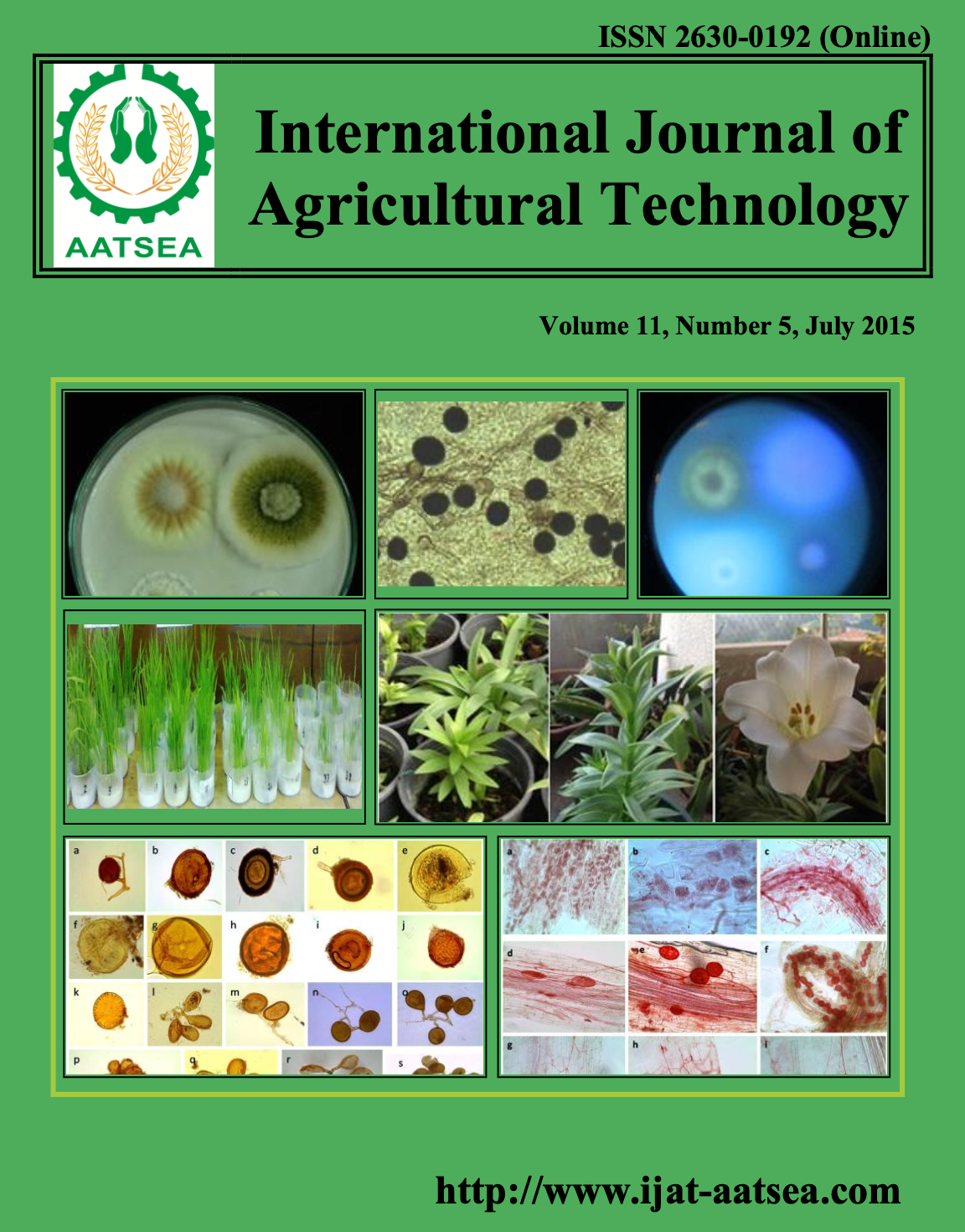Screening of antagonistic bacteria for controlling Cercospora coffeicola in Arabica coffee
Main Article Content
Abstract
Brown eye spot disease caused by Cercospora coffeicola were collected from Omkoi district, Chiang Mai, Thailand. Thirty isolates of antagonistic bacteria were obtained from rhizosphere of coffee plant. The isolates were purified and assay to inhibit growth of the C. coffeicola. The antagonistic bacteria isolates A74 and A75 showed the highest percentage of growth inhibit against C. coffeicola with 58.33% and 61.67% respectively. Based on the morphological and biochemical properties, isolate A74 and A75 were identified to be a Bacillus megaterium and Bacillus badius respectively. Isolates A74 and A75 were developed for the powder formulation, contained 20 ml of cell bacteria suspension were mixed with 43.5 g of rice flour, 1.5 ml of rice bran oil, 5 g of sucrose. After that, the mixture completely were oven dried at 45◦C for 12 hr and then bio-product were blender to form a powder. The antagonistic bacteria in bio-product can survive for more than 3 months under storage at room temperature. The efficacy for controlling leaf spot disease of bio-product in a greenhouse was tested. The result showed that the disease severity was reduced when spraying with A74 or A75 for 24 hr before or after the pathogen inoculation on coffee leaf. Therefore, bio-product A74 or A75 as a potential biological control agent against C. coffeicola in seedling.
Article Details

This work is licensed under a Creative Commons Attribution-NonCommercial-NoDerivatives 4.0 International License.
References
Agrios, G. N. (2004). Plant Pathology fifth. London: Elsevier Academic Press. 952 pp.
Ahmad, F., Ahmad, I. and Khan, M. S. (2006). Screening of free-living rhizospheric bacteria for their multiple plant growth promoting activities. Microbiological Research 163:173-181.
Babu, A. M., Philip, T., Kariappa, B. K. and Kamble, C. K. (2009). Scanning electron microscopy of the infection process of Cercospora henningsii on cassava leaves. Journal of Phytopathology 157:57-62.
Cappuccino, J. C. and Sherman, N. (1992). In: Microbiology: A Laboratory Manual. New York:
Benjamin-Cumming Publishing Company. pp. 125-179.
Choi, Y. W., Hyde, K. D. and Ho, W. H. (1999). Single spore isolation of fungi. Fungal Diversity 3:29-38.
Collin, D. P. and Jacobsen, J. (2003). Optimizing a Bacillus subtilis isolate for biological control of sugar beet Cercospora leaf spot. Biological Control 26:153-161.
EL-Hassan, S. A. and Gowen, S. R. (2006). Formulation and delivery of the bacterial antagonist Bacillus subtilis for management of lentil vascular wilt caused by Fusarium oxysporum f. sp. lentis. Journal of Phytopathology 154:148-155.
Emmert, E. A. B. and Handelsman, J. (1999). Biocontrol of plant disease: a (Gram-) positive perspective. FEMS Microbiology Letters 171:1-9.
Gupta, V. P., Tewari, S. K., Govindaian, B. A .K. and Datta, P. K. (1995). Observation on the surface ultrastructure of conidial stage of Cercospora moricola and its infection process in mulberry. Sericologia 35:123-128.
Jasim, B., Joseph, A. A., John, C. J., Mathew, J. and Radhakrishnan, E. K. (2013). Isolation and characterization of plant growth promoting endophytic bacteria from the rhizome of Zingiber officinale. 3 Biotech 4:197-204.
Kanjanamaneesathian, M., Wiwattanapatapee, R., Rotniam, W., Pengnoo, A., Wongpetkhiew, W. and Tanmala, W. (2013). Application of a suspension concentrate formulation of Bacillus velezensis to control root rot of hydroponically-grown vegetables. New Zealand Plant Protection 66:229-234.
Knudsen, G. R. and Spurr, H. W. (1987). Field persistence and efficacy of five bacterial preparations for control of peanut leaf spot. Plant Disease 71:442-445.
Kuenpech, W. and Akarapisan, A. (2014). Biological Control of Anthracnose Disease in Lady’s Slipper Using Bacillus subtilis Isolate B6. Science Journal of Microbiology 2014:1-4.
Kueupech, W. and Akarapisan, A. (2014). Pichia sp. Y2 as a potential biological control agent for anthranose of Lady’s Slipper. Journal of Agricultural Technology 10:449-457.
Lee, J. P., Lee, S. W., Kim, C. S., Son, J. H., Song, J. H., Lee, K. Y., Kim, H. J., Jung, S. J. and Moon, B. J. (2006). Evaluation of formulations of Bacillus licheniformis for the biological control of tomato gray mold caused by Botrytis cinerea. Biological Control 37:329-337.
Lumsden, R. D., Lewis, J. A. and Fravel, D. R. (1995). Formulation and delivery of bio-control agents for use against soil-borne plant pathogens. In: Hall FR, Bary JW (Eds.), Biorational pest control agents formulation and delivery. Washington, DC, USA: American Chemical Society. pp. 166-182.
Lwin, K. M., Myint, M. M., Tar, T. and Aung, W. Z. M. (2012). Isolation of plant hormone (Indole-3-Acetic Acid-IAA) producing rhizobacteria and study on their effects on maize seedling. Engineering Journal 16:137-144.
Muleta, D., Assefa, F. and Granhall, U. (2007). In vitro antagonism of rhizobacteria isolated from coffea arabica L. against Emerging Fungal Coffee Pathogens. Engineering in Life Sciences 7:577-586.
Nelson, S. C. (2008). Cercospora leaf spot and berry blotch of coffee. Department of plant and environmental protection sciences. College of Tropical Agriculture and Human esources University of Hawail at Manoa. Retrieved from https://www.ctahr.hawaii.edu/oc/freepubs/pdf/PD-41.pdf.
Osburn, R. M., Milner, J. L., Oplinger, E. S., Smith, R. W. and Handelsman, J. (1995). Effect of Bacillus cereus UW85 on the yield of soybean at two field sites in Wisconsin. Plant Disease 79:551-556.
Souza, A. G. C., Rodrigues, F. A., Maffta, L. A. and Mizubuti, E. S. G. (2011). Infection process of Cercospora coffeicola on Coffee leaf. Journal of Phytopathology 159:6-11.
Srimai, K. and Akarapisan, A. (2014). Bacillus subtilis LBF02 as biocontrol agent against leaf spot diseases caused by Cercospora lactucae-sativae in Lettuce. Journal of Agricultural Science 6:151-158.
Wiwattanapatapee, R., Chumthong, A., Pengnoo, A. and Kanjanamaneesathian, M. (2013). Preparation and evaluation of Bacillus megaterium-alginate microcapsules for control of rice sheath blight disease. World Journal of Microbiology and Biotechnology 29:1487-1497.


